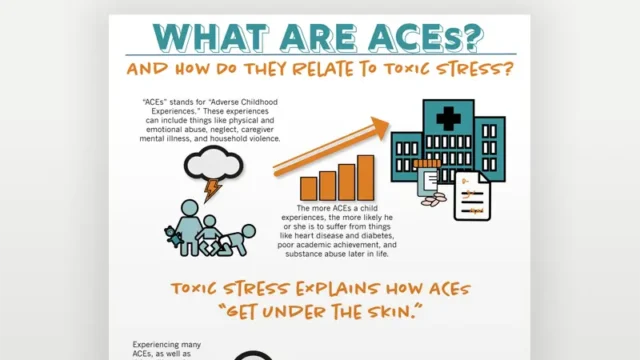ACEs and Toxic Stress: Frequently Asked Questions

What are ACEs?
The term “ACEs” is an acronym for Adverse Childhood Experiences. It originated in a groundbreaking study conducted in 1995 by the Centers for Disease Control and the Kaiser Permanente health care organization in California. In that study, “ACEs” referred to three specific kinds of adversity children faced in the home environment—various forms of physical and emotional abuse, neglect, and household dysfunction.
The key findings of dozens of studies using the original ACEs data are:
(1) ACEs are quite common, even among a middle-class population: more than two-thirds of the population report experiencing one ACE, and nearly a quarter have experienced three or more.
(2) There is a powerful, persistent correlation between the more ACEs experienced and the greater the chance of poor outcomes later in life, including dramatically increased risk of heart disease, diabetes, obesity, depression, substance abuse, smoking, poor academic achievement, time out of work, and early death.
How do ACEs relate to toxic stress?
ACEs research shows the correlation between early adversity and poor outcomes later in life. Toxic stress explains how ACEs ”get under the skin” and trigger biological reactions that lead to those outcomes. In the early 2000s, the National Scientific Council on the Developing Child coined the term “toxic stress” to describe extensive, scientific knowledge about the effects of excessive activation of stress response systems on a child’s developing brain, as well as the immune system, metabolic regulatory systems, and cardiovascular system. Experiencing ACEs triggers all of these interacting stress response systems. When a child experiences multiple ACEs over time—especially without supportive relationships with adults to provide buffering protection—the experiences will trigger an excessive and long-lasting stress response, which can have a wear-and-tear effect on the body, like revving a car engine for days or weeks at a time.
Importantly, the Council also expanded its definition of adversity beyond the categories that were the focus of the initial ACE study to include community and systemic causes—such as violence in the child’s community and experiences with racism and chronic poverty—because the body’s stress response does not distinguish between overt threats from inside or outside the home environment, it just recognizes when there is a threat, and goes on high alert.
What is trauma, and how does it connect to ACEs and toxic stress?
While trauma has many definitions, typically in psychology it refers to an experience of serious adversity or terror—or the emotional or psychological response to that experience. Trauma-informed care or services are characterized by an understanding that problematic behaviors may need to be treated as a result of the ACEs or other traumatic experiences someone has had, as opposed to addressing them as simply willful and/or punishable actions.
What can we do to help mitigate the effects of ACEs?
People who have experienced significant adversity (or many ACEs) are not irreparably damaged. There is a spectrum of potential responses to ACEs and their possible chain of developmental harm that can help a person recover from trauma caused by toxic stress.
Additional Resources
- Centers for Disease Control and Prevention: More about the original ACEs study and subsequent research.
- ACEs Too High: A site focused on news and research around ACEs.
- Substance Abuse and Mental Health Services Administration: Information on trauma-informed approaches and trauma-specific interventions.
- At the most intensive end of the spectrum are therapeutic interventions, ranging from in-patient treatment to regular sessions with a mental health professional, which are designed specifically to deal with serious trauma.
- Trauma-informed care or practice is less intensive, but affects how practitioners in a range of fields, such as social work, medicine, and education, work with people who have experienced toxic stress, and reflects an awareness of the harm that has occurred and takes that into account. There are also many less-intensive practices that can help individuals reduce the effects of stress—from meditation and breathing exercises, to physical exercise and social supports.
- ACEs-based screening and referral is an increasingly common approach, in which individuals are given an ACE score based on a brief survey of their own personal history of ACEs. This can indicate a general, non-specific sense of increased risk based on population-level probabilities, but it cannot predict accurately how any one individual will fare. In other words, a high ACE score can serve as a rough first screener to identify people who may benefit from services, but it cannot tell you what specifically you are at risk for, nor what to do about it.
- The ideal approach to ACEs is one that prevents the need for all levels of services: by reducing the sources of stress in people’s lives, whether basic needs like food, housing, and diapers, or more entrenched sources of stress, like substance abuse, mental illness, violent relationships, community crime, discrimination, or poverty. Supporting responsive relationships with a parent or caregiver can also help to buffer a child from the effects of stress, and helping children and adults build their core life skills—such as planning, focus, and self-control—can strengthen the building blocks of resilience. These three principles—reducing stress, building responsive relationships, and strengthening life skills—are the best way to prevent the long-term effects of ACEs.